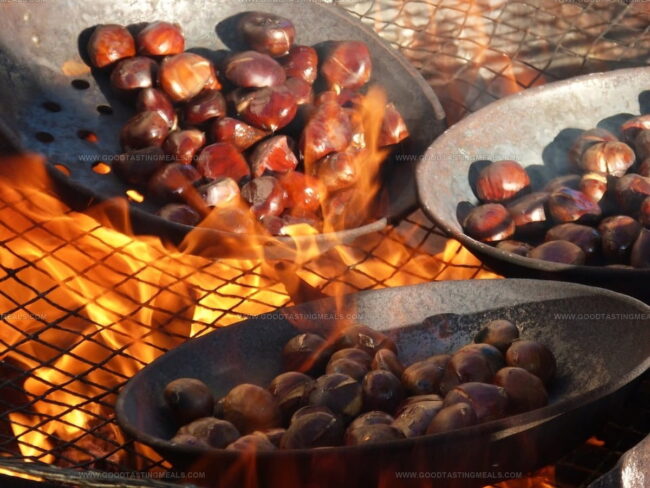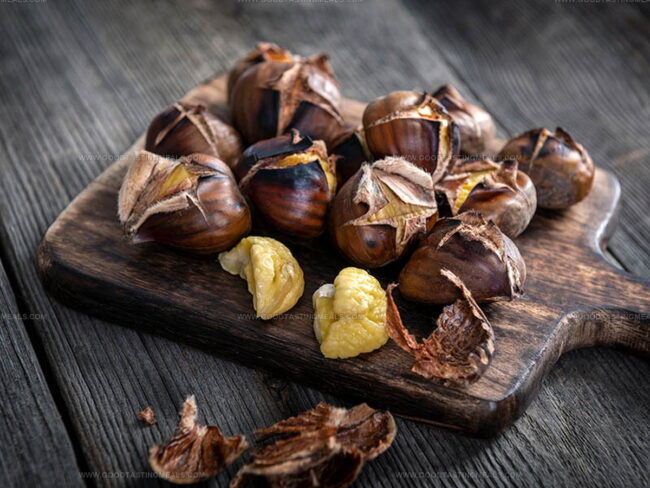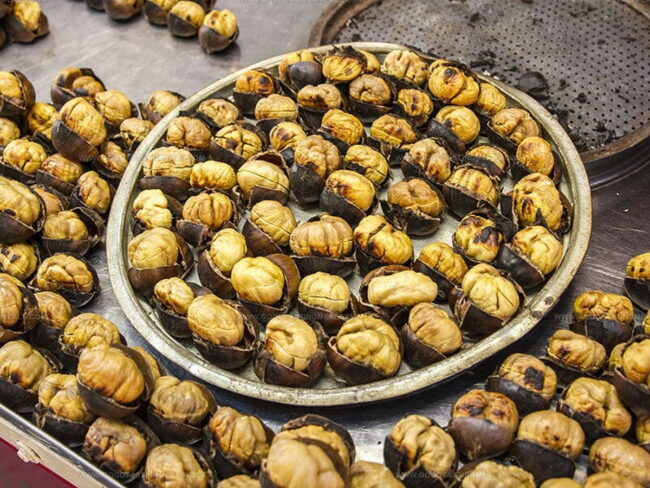What Do Roasted Chestnuts Taste Like? Sweet, Nutty Flavor in Every Bite
Roasted chestnuts carry a rich culinary tradition that sparks curiosity among food enthusiasts and holiday lovers alike.
Unique nuts transform during the roasting process, creating an intriguing sensory experience that goes beyond typical nut flavors.
Many people wonder about their distinctive characteristics and why they've become such a beloved seasonal treat.
Chestnuts differ significantly from other nuts in texture and flavor profile, making them a fascinating culinary subject.
Their popularity during winter celebrations suggests something special awaits those willing to learn more.
Street vendors and festive markets often showcase these aromatic nuts, hinting at their cultural significance.
Your taste buds are in for a delightful journey of understanding what makes roasted chestnuts so memorable and cherished.
What Are Roasted Chestnuts?
Roasted chestnuts sit snugly inside prickly husks, with clusters holding up to seven nuts.
These nuts carry a smooth, shiny dark brown surface, marked by a flat and rounded shape from being squeezed tightly within their protective shell.
Chefs work magic with chestnuts through multiple cooking methods.
Roasting, boiling, steaming, deep-frying, and microwaving all transform these nuts into delectable treats.
Cooked chestnuts bring a soft, delicate texture and a mellow, buttery sweetness similar to sweet potatoes.
Cooks often mix them into soups and stews, mashing them with butter for a rich side dish.
Chestnut recipes span sweet and savory worlds, showing up in stuffings, meat dishes, and desserts like Mont Blanch.
Sugary candied versions add another layer of deliciousness.
Chestnut flour works wonders in European kitchens, creating fritters, cakes, polenta, and even pasta dishes that showcase its unique flavor and versatility.
Flavor of Roasted Chestnuts
Raw chestnuts feel rough and taste sharp, but roasting changes everything.
Warm chestnuts become soft and sweet, almost like a baked potato.
Their flavor shifts from harsh to mellow when heat works its magic.
Roasted chestnuts carry a rich nutty taste with gentle sweetness.
Their texture becomes smooth and welcoming, unlike their raw state.
These little treasures are not overly sugary, which makes them perfect for mixing into different dishes.
Chefs love how well they blend with other ingredients.
Roasting brings out incredible flavors in chestnuts.
Skillet or oven methods work well, but an open flame creates the most delicious results.
Cutting them before roasting helps remove the outer skin more easily.
Soft and warm, these nuts add depth to many recipes.
Bakers and cooks appreciate how versatile chestnuts can be when prepared with care.
How To Roast Chestnuts In The Oven
Roasted chestnuts come fresh from an oven on a baking sheet. Chestnut roasting offers multiple methods, with this being one of the simplest approaches.
Specific details about temperatures, measurements, and roasting times exist elsewhere, but here's a basic guide for baking chestnuts:
Sharp knives work best for cutting through shells down to chestnut meat.
Roast between 375 and 425 degrees until shell edges brown and start separating at cut marks.
Peel them quickly after cooling enough to handle safely. Waiting too long makes shell removal difficult.
Pinch skin edges and pull shells off smoothly. Also strip away thin papery membrane between shell and inner chestnut meat.
Texture of Roasted Chestnuts
Roasted chestnuts boast a unique texture that feels different from other nuts. Chestnuts carry significant nutritional value, which we'll discuss before exploring their potential uses at home.
Nutrition Facts About Chestnuts
Nutritional benefits of chestnuts are quite remarkable, especially when comparing them to other nuts.
Half a cup of chestnuts provides 35 to 40% of daily vitamin C needs.
Boiling or roasting chestnuts might reduce some vitamins, but they still offer about 20% of recommended vitamin C intake.
Antioxidants remain present in these tasty nuts.
Cooking chestnuts actually increases their antioxidant content.
High levels of ellagic and gallic acid support heart health by potentially preventing cardiovascular problems and reducing risks of chronic heart disease.
Digestive wellness gets a significant boost from chestnuts.
Rich fiber content supports good bacteria growth in intestines and helps create smoother bowel movements.
Celiac disease sufferers appreciate these nuts for being naturally gluten-free.
Chestnut consumption can slow down starch absorption in our bodies.
Regular eating helps maintain steady blood sugar levels.
Fiber within chestnuts plays a key role in stabilizing blood glucose.
Diabetes management becomes easier with chestnuts.
Their low glycemic index of 54 means minimal blood sugar fluctuations occur after eating them.
Steady sugar levels make chestnuts an excellent nutritional choice for many people.
Cooking With Chestnuts
Roasting chestnuts brings delightful options for cooking and snacking.
Scoring the chestnut shell helps prevent unexpected explosions during cooking.
Making an X mark on each chestnut stops pressure from building and makes removing the shell much easier.
Chestnut roasting works well in an oven when an open fire isn't available.
Raw chestnuts taste bitter, so cooking removes that unpleasant flavor.
Chefs often use roasted chestnuts for creating sweet treats like chocolates and confections.
Cooking peeled chestnuts with fragrant spices creates wonderful soup bases.
Blending cooked chestnuts with fresh herbs and cream makes a smooth, rich mixture.
Soups benefit from chestnut puree because of its creamy texture and deep flavor.
Chestnut hummus works as a unique alternative to traditional chickpea versions.
Seasoned roasted chestnuts also make an excellent standalone snack for anyone wanting something simple and tasty.
Roasting techniques matter when preparing these delicious nuts.
Careful scoring and cooking helps ensure maximum flavor and enjoyment.
Chestnut dishes range from simple snacks to complex recipes that showcase their rich, smooth qualities.
How to Serve Roasted Chestnuts
Chestnuts pack so much deliciousness that making the most of them after careful roasting becomes a delightful culinary goal.
Roasted chestnuts work wonderfully in soup recipes, which many food lovers appreciate for their rich flavor profile.
Chestnuts naturally offer a creamy consistency that blends seamlessly into soup preparations.
Soup makers can choose between smooth blending or keeping chestnut chunks for added texture, though blending typically produces better results.
Chestnut hummus serves as an excellent alternative for those tired of traditional chickpea-based dips.
Smooth and rich, this version lacks the graininess of standard hummus while maintaining a similar taste experience.
Roasted chestnuts bring wonderful depth to vegan Wellington dishes, contributing both creamy smoothness and delectable flavor notes.
Are Chestnuts Good for Your Health?
Chestnuts continue providing health benefits even after cooking, thanks to their rich antioxidant content called polyphenols.
Cooking increases levels of garlic acid and ellagic acid, two powerful antioxidants.
Minerals like magnesium and potassium work together to reduce risks of heart disease and stroke when consumed in sufficient quantities.
Roasted chestnuts serve more than just a simple snack purpose.
Chefs appreciate their versatility in enhancing salads and soups with delightful flavor profiles.
Nutritional value remains high after cooking, with carbohydrates dominating their composition and minimal fat content.
Nutrient similarities to cereals make chestnuts a smart dietary choice.
Roasting softens their texture and reduces bitterness, creating a more pleasant eating experience.
Do Chestnuts Taste Like Hazelnuts?
Chestnuts stand out from other nuts with their special taste.
Unlike hazelnuts, almonds, and walnuts, these nuts feel like a sponge and seem just a bit less firm.
Roasting chestnuts brings out a delicate sweetness mixed with a subtle nutty hint that barely comes through.
Do Chestnuts Have a Chicken Flavor?
Chestnuts carry a delicate taste that works well in different kinds of dishes. Raw chestnuts have a flavor somewhat like potatoes - slightly sharp and crisp.
When cooked, these nuts change completely and become creamy and sweet. Their taste resembles sweet potatoes, with a soft and rich quality that makes them special in many recipes.
What Makes Chestnuts Taste So Good?
Chestnuts pack a powerful punch of health benefits with numerous vitamins and minerals.
These tasty nuts contain manganese, copper, vitamin B6, vitamin C, thiamine, folate, riboflavin, and potassium.
Nutrient-dense chestnuts offer more than just great flavor.
Fiber content stands out as another key advantage, with just 10 roasted chestnuts delivering 15% of your recommended daily intake.
Roasted vs. Boiled Chestnuts: Taste Differences
Roasted and boiled chestnuts each bring out different flavors and textures, so your choice depends on what you’re in the mood for.
Roasting brings out richer flavors and a bit more sweetness, while boiling gives you a tender, mellow snack that’s easy to enjoy on its own or in recipes.



